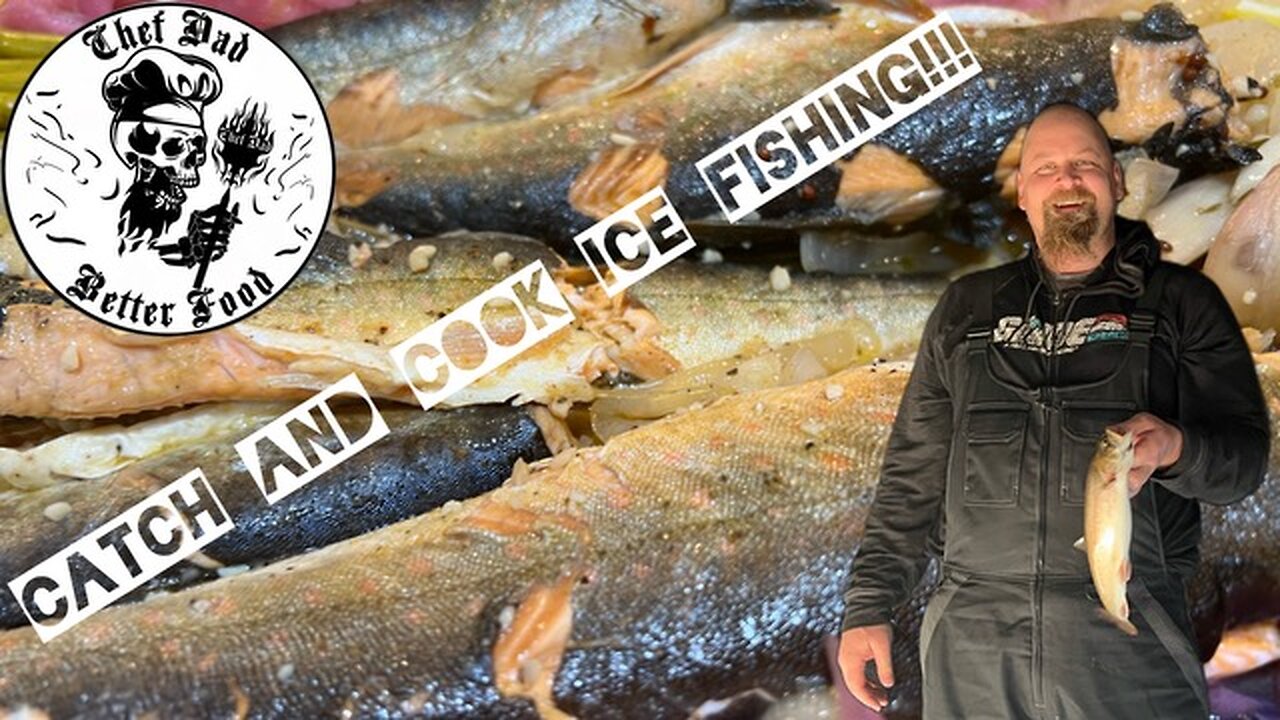Premium Only Content

Catch and Cook Ice Fishing!!!
ce fishing is a great way to spend time with your family!!!
Ice Fishing: A Comprehensive Guide
Ice fishing is a beloved winter pastime that has been practiced for centuries in cold regions around the world. This traditional method of fishing involves catching fish through a hole drilled into the frozen surface of a body of water, such as a lake, pond, or river. Whether you are a seasoned ice angler or a beginner looking to try this unique outdoor activity, understanding the history, techniques, equipment, safety considerations, and best practices of ice fishing is essential for a successful and enjoyable experience.
History of Ice Fishing
Ice fishing has a rich history that dates back thousands of years. Indigenous peoples in cold climates relied on ice fishing as a means of sustenance and survival during harsh winter months. They used primitive tools and techniques to catch fish through holes in the ice, often employing methods passed down through generations.
Over time, as civilizations developed and technology advanced, ice fishing evolved into a popular recreational activity enjoyed by people of all ages and backgrounds. European settlers in North America adopted ice fishing from native tribes and incorporated their own innovations and techniques into the practice.
Today, ice fishing remains a cherished tradition in many cold-weather regions, with modern anglers utilizing advanced equipment and gear to enhance their fishing experience on the ice.
Techniques of Ice Fishing
Successful ice fishing requires a combination of skill, knowledge, and patience. Here are some key techniques commonly used by ice anglers:
1. **Drilling Holes**: The first step in ice fishing is drilling holes through the thick ice to access the water below. Anglers use specialized tools called ice augers to create these openings. The size and placement of the holes depend on factors such as the targeted fish species and fishing conditions.
2. **Setting Up Equipment**: Once the holes are drilled, anglers set up their fishing equipment near the holes. This typically includes a fishing rod, reel, and bait. Some anglers also use tip-ups, which are mechanical devices that signal when a fish has taken the bait.
3. **Using Bait**: Choosing the right bait is crucial for attracting fish. Common types of bait used in ice fishing include live minnows, worms, maggots, and artificial lures. The bait is typically placed on a hook and lowered into the water below the ice.
4. **Patience and Observation**: Ice fishing requires patience and keen observation. Anglers must wait for fish to bite and pay attention to subtle movements or signals that indicate fish activity near the bait.
5. **Jigging**: Jigging is a popular technique in ice fishing where anglers move the bait up and down in the water to attract fish. This motion mimics the movement of natural prey and can be effective in enticing fish to bite.
Equipment for Ice Fishing
Having the right equipment is essential for a successful and comfortable ice fishing experience. Here are some key pieces of equipment commonly used by ice anglers:
1. **Ice Auger**: An ice auger is a tool used to drill holes in the ice. There are manual augers that require physical effort to operate and powered augers that use gasoline or electricity for drilling.
2. **Ice Shelter**: Ice shelters, also known as ice shanties or ice huts, provide protection from the elements and help anglers stay warm during long hours on the ice. These shelters come in various styles, from portable pop-up tents to more permanent structures with heaters and seating.
Reel**: Specialized ice fishing rods are designed to be shorter and more sensitive than traditional fishing rods. These rods are better suited for detecting subtle bites in cold water conditions. Ice fishing reels are often small and lightweight to accommodate the shorter rods.
5. **Bait and Lures**: Choosing the right bait and lures is crucial for attracting fish. Live bait such as minnows, worms, or maggots are commonly used in ice fishing. Additionally, artificial lures designed for ice fishing can be effective in enticing fish to strike.
6. **Ice Scoop**: An ice scoop is a handy tool for clearing ice shavings and slush from the fishing hole. Keeping the hole clear allows for better visibility and prevents the hole from freezing over.
8. **Warm Clothing and Gear**: Staying warm and comfortable is essential when ice fishing in cold weather. Layered clothing, insulated boots, gloves, hats, and hand warmers can help anglers stay cozy during long hours on the ice.
#food
#shortscooking #subscribe #youtube #cooking #recipe #homemade #eats #bbq #shorts #cook #foodie #newvideo #youtuber #keepsupporting #grill #feedshorts #viral #bbq #foodie #short #burger #best #love
#creative #steak #good #youtuber #sub #subscribers #quesadillas #one #foodies #trending #trendingshorts #shortsfeed #shortfeed #lobster #valentinesday #crab #dungenesscrab #amazing #weird
-
 27:00
27:00
Squaring The Circle, A Randall Carlson Podcast
17 hours agoSPECIAL EPISODE: #037 Randall Carlson Explains The Vital Role of Sacred Geometry in the Modern Age
1.21K2 -
 58:35
58:35
Trumpet Daily
19 hours ago $3.71 earnedThe Trade War Begins - Trumpet Daily | Feb. 3, 2025
3.11K18 -
 47:03
47:03
Uncommon Sense In Current Times
17 hours agoArrested For Praying Silently in Western Culture and Convicted
2.05K -
 44:19
44:19
PMG
15 hours ago $0.01 earnedIn the wake of a tragedy! Finding hope in broken times
400 -
 3:40:50
3:40:50
FreshandFit
9 hours agoGirls Get Exposed As THOTS After Demanding Millionaires?!
90.6K106 -
 5:30:06
5:30:06
SpartakusLIVE
13 hours ago#1 King of Content kicks off YOUR week with Monday MOTIVATION
110K8 -
 5:56:52
5:56:52
Akademiks
11 hours agoKendrick Lamar Sweeps Grammys. Drake announces new album on Feb 14. Rocky Trial Might get Dismissed?
89.2K6 -
 3:25:02
3:25:02
BrancoFXDC
9 hours ago $2.74 earnedWarzone Rebirth Rounds
46.1K -
 1:44:14
1:44:14
Glenn Greenwald
15 hours agoRubio's Shift: What is Trump's Foreign Policy? Trump/Musk Attack CIA Fronts USAID & NED: With Mike Benz | SYSTEM UPDATE #401
101K99 -
 1:05:47
1:05:47
Donald Trump Jr.
17 hours agoMexico Sends Troops to Border, Plus USAid Scam Exposed, Live with Brooke Goldstein & Rep Brian Mast | TRIGGERED Ep.213
248K315